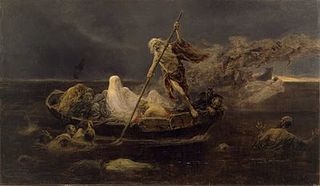La Laguna Estigia
1887 painting by Félix Resurrección Hidalgo
| La Laguna Estigia | |
|---|---|
 | |
| Artist | Félix Resurrección Hidalgo |
| Year | 1887 |
La Laguna Estigia (The River Styx or The Styx), also known simply as Laguna Estigia,[1] is an 1887 Greco-Roman painting by Filipino painter Félix Resurrección Hidalgo. It is a companion-piece for Hidalgo's other painting entitled La barca de Aqueronte. Like the La barca de Aqueronte, the La Laguna Estigia on Dante's Inferno, the pa[2]
The painting was a silver medalist during the 1887 Exposicion General de las Islas Filipinas in Madrid, Spain.[3]
References
- ^ Kulay-Diwa Gallery of Philippine Contemporary Art (2009). "Felix Ressurreccion Hidalgo". Archived from the original on 15 July 2010. Retrieved 28 March 2010.
- ^ "La Laguna Estigia (The River Styx) from La Barca de Aqueronte". Lopez Memorial Museum. 2003. Archived from the original on 14 January 2010. Retrieved 28 March 2010.
- ^ "La Laguna Estigia (The River Styx) from Module Three - El Asesinato Del Governador Bustamante Y Su Hijo: Powerand Conflict" (PDF). Lopez Memorial Museum. Archived from the original (PDF) on 16 July 2011. Retrieved 28 March 2010.
- v
- t
- e
Dante's Divine Comedy
and locations
| Architecture |
|
|---|---|
| Cinema |
|
| Illustrations |
|
| Literature |
|
| Music (classical) |
|
| Music (modern) |
|
| Paintings |
|
| Sculptures |
|
| Video games |
|
 Category
Category
 | This article about a nineteenth-century painting is a stub. You can help Wikipedia by expanding it. |
- v
- t
- e













